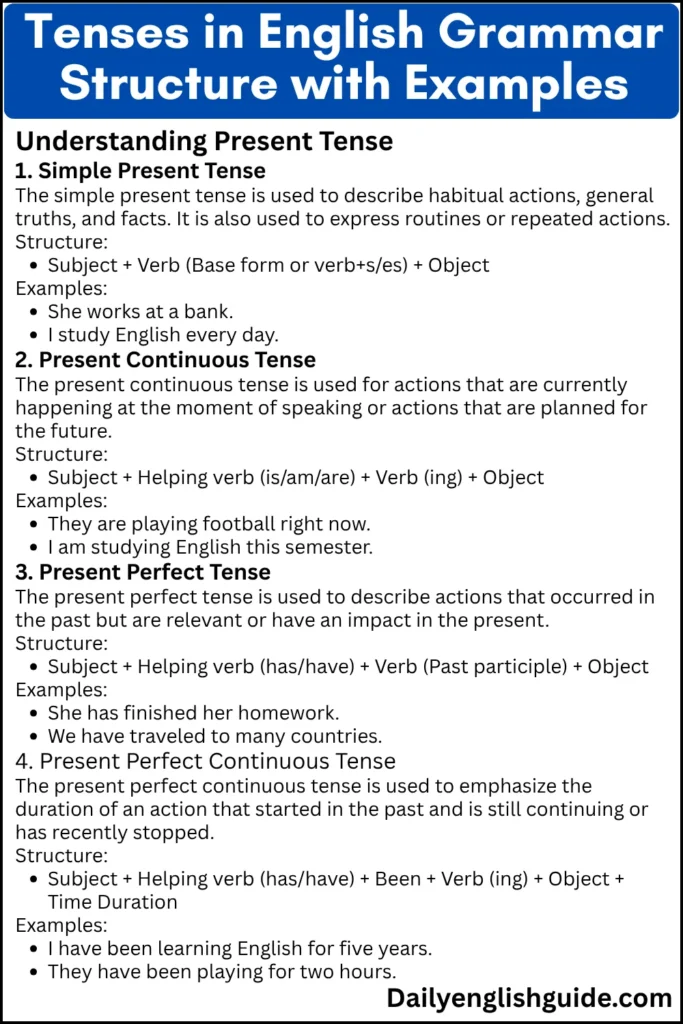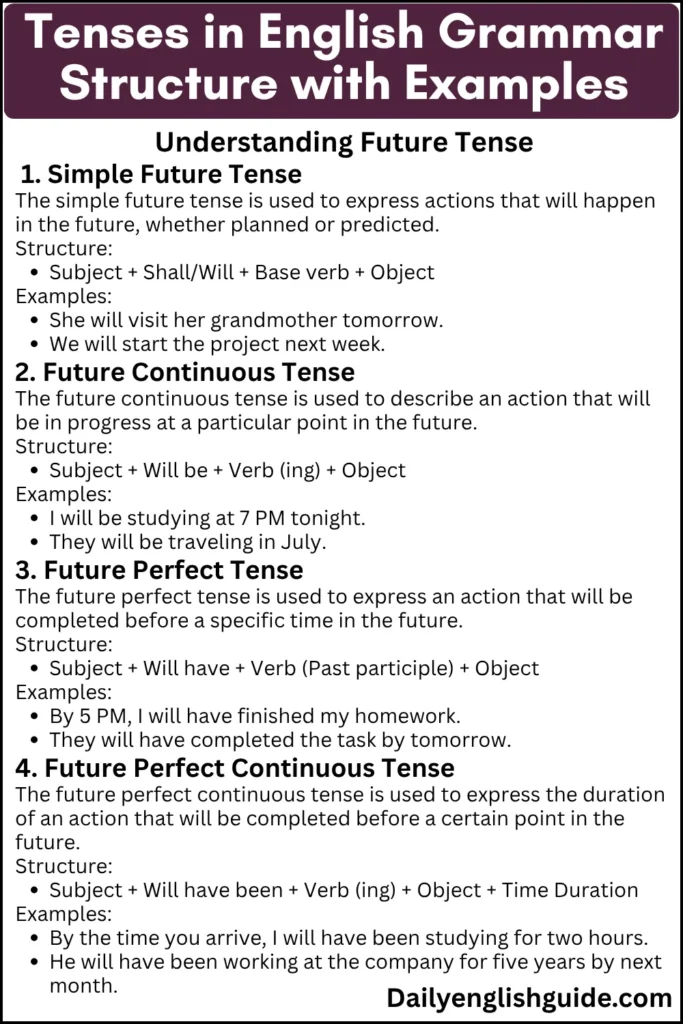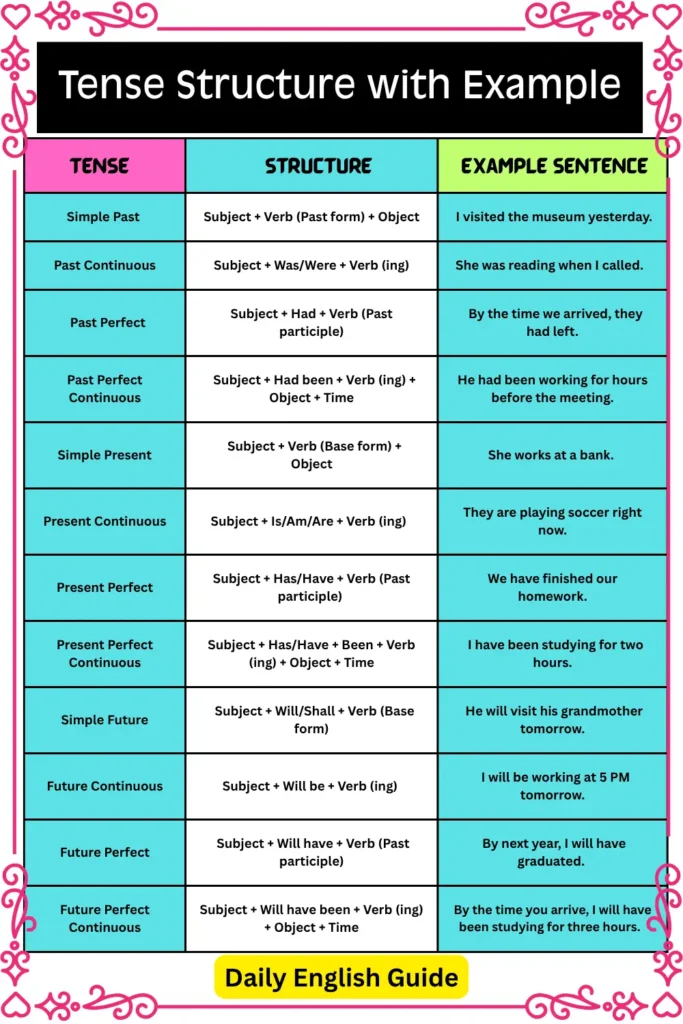Understanding tenses is an essential part of mastering the English language. It is an integral aspect of both verbal and written communication, as tenses help convey when an action or event takes place. Without a clear understanding of tenses, your message may become ambiguous or misinterpreted. This article provides a detailed and comprehensive guide to the tenses in English grammar, with examples and clear explanations to help you understand how and when to use each tense.
What Are Tenses in English Grammar?
Tenses are verb forms that indicate the time an action occurred, is occurring, or will occur. In simple terms, the tense of a verb provides information about whether the action or event is in the past, present, or future. Each tense category further branches out into specific types, making it essential to know their structure and usage.

Types of Tenses
In English grammar, tenses are divided into three primary categories:
-
-
-
Past Tense
-
Present Tense
-
Future Tense
-
-
Each of these categories is further divided into different subtypes based on the duration, completion, or continuity of the action.
The Structure for Each Tense:
| Tense | Structure |
|---|---|
| Simple Past | Subject + Verb (Past form) + Object |
| Past Continuous | Subject + Was/Were + Verb (ing) + Object |
| Past Perfect | Subject + Had + Verb (Past participle) + Object |
| Past Perfect Continuous | Subject + Had been + Verb (ing) + Object + Time Duration |
| Simple Present | Subject + Verb (Base form or Verb+s/es) + Object |
| Present Continuous | Subject + Is/Am/Are + Verb (ing) + Object |
| Present Perfect | Subject + Has/Have + Verb (Past participle) + Object |
| Present Perfect Continuous | Subject + Has/Have + Been + Verb (ing) + Object + Time Duration |
| Simple Future | Subject + Will/Shall + Verb (Base form) + Object |
| Future Continuous | Subject + Will be + Verb (ing) + Object |
| Future Perfect | Subject + Will have + Verb (Past participle) + Object |
| Future Perfect Continuous | Subject + Will have been + Verb (ing) + Object + Time Duration |

Understanding Past Tense
The past tense is used to describe actions that happened before the current moment. It indicates that an event or action has already taken place.
Subtypes of Past Tense:
-
Simple Past Tense
-
Past Continuous Tense
-
Past Perfect Tense
-
Past Perfect Continuous Tense
1. Simple Past Tense
The simple past tense is used when an event has happened and is no longer happening. The event could be a one-time action or an event that occurred regularly in the past.
Structure:
-
Subject + Verb (2nd form) + Object
Examples:
-
He visited his grandmother yesterday.
-
We watched a movie last night.
2. Past Continuous Tense
The past continuous tense is used to describe actions that were ongoing or in progress at a specific time in the past. It can also indicate two actions that were happening simultaneously.
Structure:
-
Subject + Helping verb (was/were) + Verb (ing) + Object
Examples:
-
I was studying when you called.
-
They were playing football at 5 PM yesterday.
3. Past Perfect Tense
The past perfect tense is used to describe an event that happened before another event in the past. It is often used to show the order of events.
Structure:
-
Subject + Had + Verb (Past participle) + Object
Examples:
-
She had finished the project before the meeting started.
-
I had visited London twice before I moved there.
4. Past Perfect Continuous Tense
The past perfect continuous tense is used to indicate an action that began in the past, continued for some time, and was completed before another action in the past.
Structure:
-
Subject + Had been + Verb (ing) + Object + Time of Action
Examples:
-
They had been waiting for an hour when the train finally arrived.
-
I had been reading the book for hours before I took a break.

Understanding Present Tense
The present tense is used to describe actions happening now or regularly, facts, and situations that are general or permanent.
Subtypes of Present Tense:
-
Simple Present Tense
-
Present Continuous Tense
-
Present Perfect Tense
-
Present Perfect Continuous Tense
1. Simple Present Tense
The simple present tense is used to describe habitual actions, general truths, and facts. It is also used to express routines or repeated actions.
Structure:
-
Subject + Verb (Base form or verb+s/es) + Object
Examples:
-
She works at a bank.
-
I study English every day.
2. Present Continuous Tense
The present continuous tense is used for actions that are currently happening at the moment of speaking or actions that are planned for the future.
Structure:
-
Subject + Helping verb (is/am/are) + Verb (ing) + Object
Examples:
-
They are playing football right now.
-
I am studying English this semester.
3. Present Perfect Tense
The present perfect tense is used to describe actions that occurred in the past but are relevant or have an impact in the present.
Structure:
-
Subject + Helping verb (has/have) + Verb (Past participle) + Object
Examples:
-
She has finished her homework.
-
We have traveled to many countries.
4. Present Perfect Continuous Tense
The present perfect continuous tense is used to emphasize the duration of an action that started in the past and is still continuing or has recently stopped.
Structure:
-
Subject + Helping verb (has/have) + Been + Verb (ing) + Object + Time Duration
Examples:
-
I have been learning English for five years.
-
They have been playing for two hours.
Understanding Future Tense
The future tense is used to describe actions that will take place after the current moment. It is often used to express predictions, promises, and plans.
Subtypes of Future Tense:
-
Simple Future Tense
-
Future Continuous Tense
-
Future Perfect Tense
-
Future Perfect Continuous Tense
1. Simple Future Tense
The simple future tense is used to express actions that will happen in the future, whether planned or predicted.
Structure:
-
Subject + Shall/Will + Base verb + Object
Examples:
-
She will visit her grandmother tomorrow.
-
We will start the project next week.
2. Future Continuous Tense
The future continuous tense is used to describe an action that will be in progress at a particular point in the future.
Structure:
-
Subject + Will be + Verb (ing) + Object
Examples:
-
I will be studying at 7 PM tonight.
-
They will be traveling in July.
3. Future Perfect Tense
The future perfect tense is used to express an action that will be completed before a specific time in the future.
Structure:
-
Subject + Will have + Verb (Past participle) + Object
Examples:
-
By 5 PM, I will have finished my homework.
-
They will have completed the task by tomorrow.
4. Future Perfect Continuous Tense
The future perfect continuous tense is used to express the duration of an action that will be completed before a certain point in the future.
Structure:
-
Subject + Will have been + Verb (ing) + Object + Time Duration
Examples:
-
By the time you arrive, I will have been studying for two hours.
-
He will have been working at the company for five years by next month.

Tense Structure with Example:
| Tense | Structure | Example Sentence |
|---|---|---|
| Simple Past | Subject + Verb (Past form) + Object | I visited the museum yesterday. |
| Past Continuous | Subject + Was/Were + Verb (ing) | She was reading when I called. |
| Past Perfect | Subject + Had + Verb (Past participle) | By the time we arrived, they had left. |
| Past Perfect Continuous | Subject + Had been + Verb (ing) + Object + Time | He had been working for hours before the meeting. |
| Simple Present | Subject + Verb (Base form) + Object | She works at a bank. |
| Present Continuous | Subject + Is/Am/Are + Verb (ing) | They are playing soccer right now. |
| Present Perfect | Subject + Has/Have + Verb (Past participle) | We have finished our homework. |
| Present Perfect Continuous | Subject + Has/Have + Been + Verb (ing) + Object + Time | I have been studying for two hours. |
| Simple Future | Subject + Will/Shall + Verb (Base form) | He will visit his grandmother tomorrow. |
| Future Continuous | Subject + Will be + Verb (ing) | I will be working at 5 PM tomorrow. |
| Future Perfect | Subject + Will have + Verb (Past participle) | By next year, I will have graduated. |
| Future Perfect Continuous | Subject + Will have been + Verb (ing) + Object + Time | By the time you arrive, I will have been studying for three hours. |
